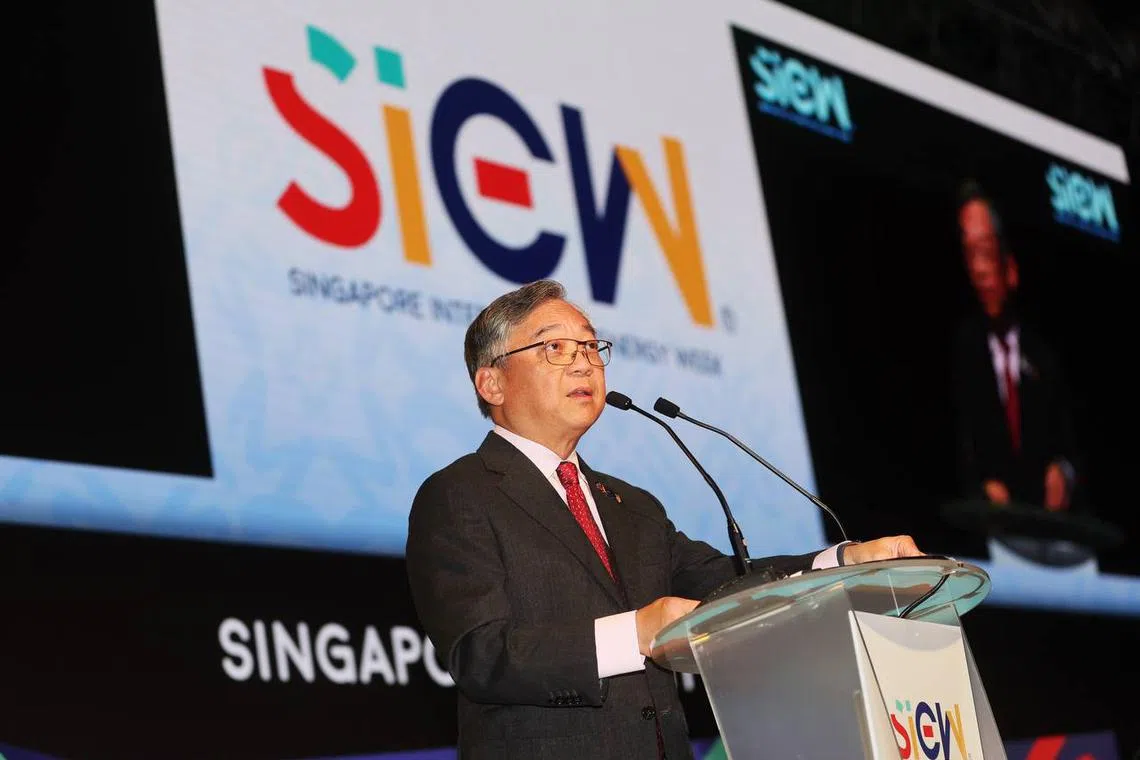Singapore a step closer to using low-carbon ammonia for bunkering, power generation
Sign up now: Get ST's newsletters delivered to your inbox

Trade and Industry Minister Gan Kim Yong said an international supply chain and the technology for transporting ammonia are well established.
ST PHOTO: KELVIN CHNG
Follow topic:
SINGAPORE – The Republic is about to embark on one of the first commercial projects in the world to utilise ammonia for bunkering and power generation, after setting its sights on using hydrogen for about 50 per cent of its energy needs by 2050.
Minister for Trade and Industry Gan Kim Yong said on Monday that an international supply chain and the technology for transporting ammonia are well established.
“Ammonia also has the potential to be used directly as fuel for power generation and maritime shipping,” Mr Gan noted.
He was speaking on the first day of Singapore International Energy Week at Marina Bay Sands. The event will run until Friday.
Ammonia is formed when hydrogen combines with nitrogen from ambient air. As a hydrogen carrier, it can be stored at room temperature and is easy to transport.
Hydrogen is seen as a clean fuel as it does not produce any planet-warming carbon dioxide when burned.
The project will involve developing an end-to-end ammonia solution to generate 55 megawatts (MW) to 65MW of electricity from imported low-carbon or zero-carbon ammonia via direct combustion in a gas turbine or combined cycle gas turbine, said the Energy Market Authority (EMA) on Monday.
The project will be located on Jurong Island.
The project developer, which will be working closely with the Government, will also have to facilitate ammonia bunkering at a capacity of at least 100,000 tonnes per annum, starting with shore-to-ship bunkering, followed by ship-to-ship bunkering.
Since EMA and the Maritime and Port Authority of Singapore launched an invitation for expressions of interest for the project in December 2022,
Six consortia have been shortlisted to participate in the next step – a request for proposal to be launched by end-2023 to help the Government choose a lead developer for the project.
While the Government is experimenting with advanced hydrogen technologies that are almost commercially ready through such projects, it is also exploring other low-carbon energy sources such as nuclear energy, said Mr Gan.
Though no decision has yet been made on deploying nuclear power here, the Government still needs to build capabilities to understand advanced nuclear energy technologies that are becoming safer and have the potential to be cost-competitive, he added.
This will allow the authorities to study the options seriously when newer technologies later prove to be viable, said Mr Gan, who noted that there is a growing interest in nuclear energy among countries in the region.
“We have been engaging international organisations such as the International Atomic Energy Agency (IAEA) to learn from the world’s best, and we are working with our neighbours through Asean platforms to facilitate information-sharing and collectively build up the region’s capabilities,” said the minister.
For instance, the Republic is building up expertise to better understand advanced nuclear technologies, such as small modular reactors (SMRs), and their suitability for Singapore.
These reactors harness nuclear fission to generate heat and produce energy, and have a power capacity of up to 300MW per unit, about one-third the generation capacity of traditional nuclear power reactors, according to the IAEA.
Mr Gan noted that some SMRs are designed to cool safely and passively without requiring external systems or operator actions during emergencies.
“We will deepen our collaboration with countries that have capabilities in SMR technology to strengthen our understanding,” said Mr Gan.
At the same time, studies have been launched to better understand if Singapore could rely on geothermal heat to generate electricity, after a study by Nanyang Technological University found that a site near Sembawang hot springs could be a geothermal energy source
Studies are also under way to determine whether biofuels can be more widely adopted across different carbon-intensive sectors, said Mr Gan.
Biofuels have been supplied to ocean-going vessels, and blended sustainable aviation fuel – made from used cooking oil and animal fats – has been used for all Singapore Airlines flights.
Professor Subodh Mhaisalkar, who is the executive director of academic research at the National Research Foundation, said that ammonia could be a fuel for both power generation and shipping for years to come, before other hydrogen carrier alternatives such as liquefied hydrogen or methanol could be considered.
“There are many challenges in the utilisation of ammonia and these include transport, storage, safety, emissions management, and optimisation of both marine and power generation plants. These trials would place Singapore in a leading position in demonstrating the use of ammonia for power generation in a megacity environment,” he added.
In the short term, biofuels would be of great importance for land transport and maritime applications and as aviation fuel.
“Over the longer term, other clean energies such as geothermal and nuclear that have the potential of scaling would be important to consider,” said Prof Mhaisalkar.


